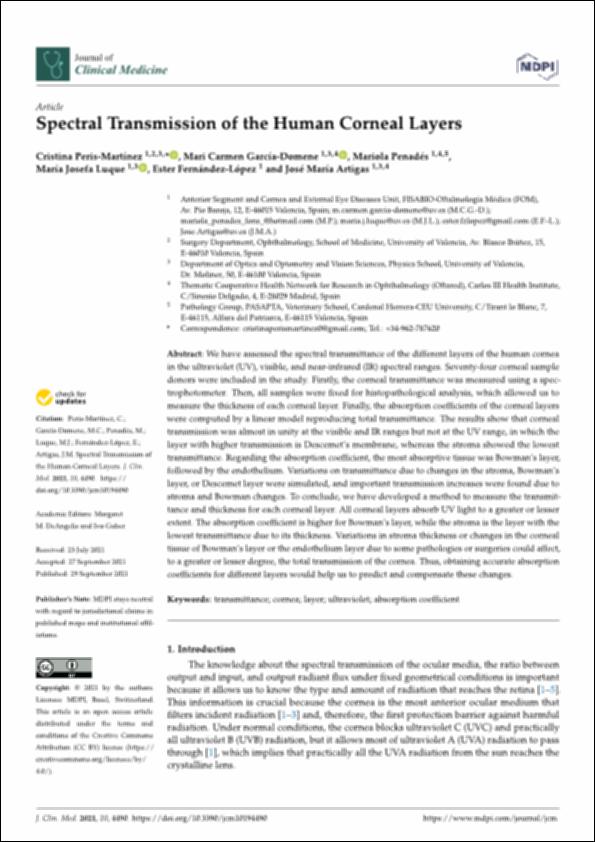Please use this identifier to cite or link to this item:
http://hdl.handle.net/10637/13599Spectral transmission of the human corneal layers
| Title: | Spectral transmission of the human corneal layers |
| Authors : | Peris Martínez, Cristina García Domene, Mari Carmen Penadés Fons, Mariola Luque Cobija, María Josefa Fernández López, Ester Artigas Verde, José María |
| Keywords: | Luz - Absorción.; Radiación ultravioleta.; Ultraviolet radiation.; Absorption spectra.; Light absorption.; Espectros de absorción.; Córnea.; Cornea. |
| Publisher: | MDPI |
| Citation: | Peris-Martínez, C., García-Domene, M. C., Penadés, M., Luque, M. J., Fernández-López, E. & Artigas, J. M. (2021). Spectral transmission of the human corneal layers. Journal of Clinical Medicine, vol. 10, i. 19 (29 sep.), art. 4490. DOI: https://doi.org/10.3390/jcm10194490 |
| Abstract: | We have assessed the spectral transmittance of the different layers of the human cornea in the ultraviolet (UV), visible, and near-infrared (IR) spectral ranges. Seventy-four corneal sample donors were included in the study. Firstly, the corneal transmittance was measured using a spectrophotometer. Then, all samples were fixed for histopathological analysis, which allowed us to measure the thickness of each corneal layer. Finally, the absorption coefficients of the corneal layers were computed by a linear model reproducing total transmittance. The results show that corneal transmission was almost in unity at the visible and IR ranges but not at the UV range, in which the layer with higher transmission is Descemet’s membrane, whereas the stroma showed the lowest transmittance. Regarding the absorption coefficient, the most absorptive tissue was Bowman’s layer, followed by the endothelium. Variations on transmittance due to changes in the stroma, Bowman’s layer, or Descemet layer were simulated, and important transmission increases were found due to stroma and Bowman changes. To conclude, we have developed a method to measure the transmittance and thickness for each corneal layer. All corneal layers absorb UV light to a greater or lesser extent. The absorption coefficient is higher for Bowman’s layer, while the stroma is the layer with the lowest transmittance due to its thickness. Variations in stroma thickness or changes in the corneal tissue of Bowman’s layer or the endothelium layer due to some pathologies or surgeries could affect, to a greater or lesser degree, the total transmission of the cornea. Thus, obtaining accurate absorption coefficients for different layers would help us to predict and compensate these changes. |
| Description: | Este artículo se encuentra disponible en la siguiente URL: https://www.mdpi.com/2077-0383/10/19/4490 Este artículo de investigación pertenece a la sección "Ophthalmology". |
| URI: | http://hdl.handle.net/10637/13599 |
| Rights : | http://creativecommons.org/licenses/by/4.0/deed.es |
| ISSN: | 2077-0383 (Electrónico) |
| Issue Date: | 29-Sep-2021 |
| Center : | Universidad Cardenal Herrera-CEU |
| Appears in Collections: | Dpto. Producción y Sanidad Animal, Salud Pública Veterinaria y Ciencia y Tecnología de los Alimentos |
Items in DSpace are protected by copyright, with all rights reserved, unless otherwise indicated.


